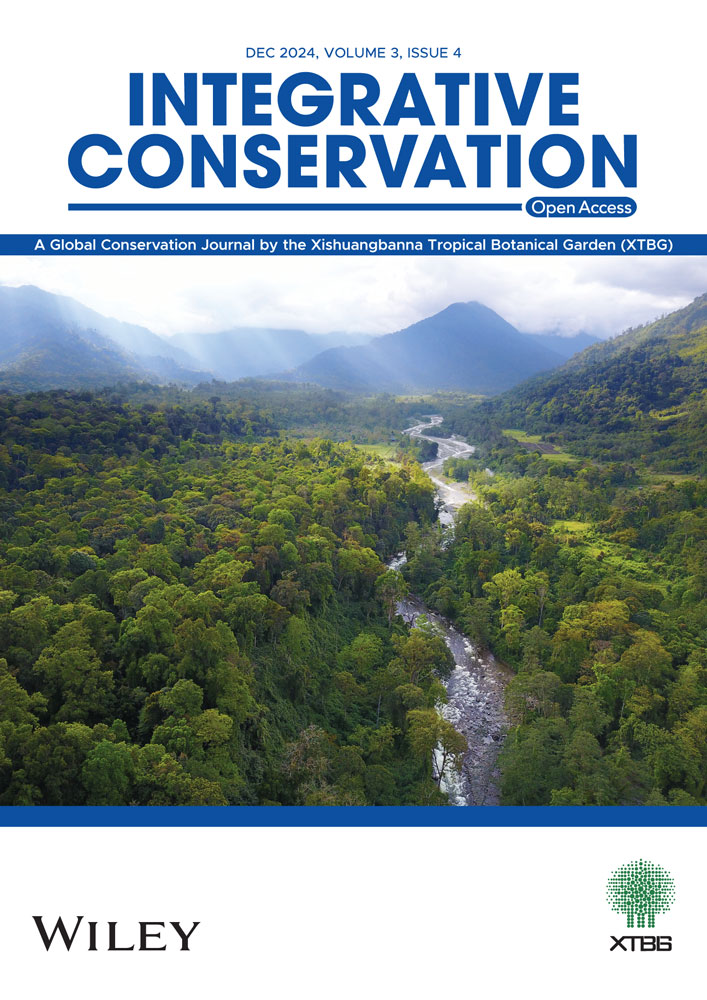Forests and Mediterranean squamates: How does crown canopy impact species richness and phylogenetic diversity?
森林与地中海有鳞目动物:树冠如何影响物种丰富度和系统发育多样性?
Editor-in-Chief: Binbin Li; Handling Editor: Akihiro Nakamura
Abstract
enIntense human disturbances, including changes in the balance between open and forested habitats, have impacted squamate reptile populations in the western Mediterranean. This region has experienced a notable increase in woodland cover, driven by the gradual abandonment of traditional agriculture, native forest regeneration and intensive reforestation. Microclimatic changes associated with dense canopies in native forests or tree plantations could affect squamate assemblages. In this study, we tested the hypothesis that squamates (amphisbaenians, lizards and snakes) would respond negatively to denser crown canopies and taller vegetation. Our study focused on the Iberian and Italian Peninsulas and included 56 squamate species. The analyses indicated that forests (>50% canopy cover) support a limited number of squamate species (24–26 species). The greatest species richness and phylogenetic diversity were found in low woodland formations (2‒9.9 m stand height and 20‒49% canopy cover) and areas with scattered trees and shrubs (5‒19% canopy cover), supporting 40–46 species. To balance reforestation efforts with squamate conservation, areas with low diversity or lack of threatened species should be prioritised.
摘要
zh严重的人类干扰已经改变了地中海西部开阔地与森林栖息地之间的平衡,并影响了其中的有鳞目爬行动物。在放弃传统农业、原生林再生以及密集造林的推动下,该地区的林地覆盖率显著增加。原生林或造林区郁闭的树冠导致微气候变化,可能会进而影响有鳞目动物的群落结构。本研究以伊比利亚半岛和亚平宁半岛的56种有鳞目动物为对象,解析树冠郁闭度和树高是否对有鳞目动物(如两栖蜥蜴、蜥蜴和蛇)丰富度造成负面影响。研究结果表明,树冠郁闭度>50%森林中的物种数量仅为24-26种。物种丰富度和系统发育多样性最高的为矮林地(树高2‒9.9 m,林冠郁闭度20‒49%)和有稀疏乔木与灌木的林地(林冠郁闭度5‒19%),其中的物种数量达40‒46个。为平衡植树造林与保护有鳞目动物之间的关系,物种多样性较低或缺乏受威胁物种的区域应成为优先区。【审阅:胡劭骥(云南大学)】
Plain language summary
enThe western Mediterranean region, which includes the Iberian and Italian Peninsulas, boasts a rich fauna of squamates. However, over the centuries, these ecosystems have undergone dramatic alterations. In recent decades, the decline of traditional agriculture, combined with native forest regeneration and replanting, has led to a notable increase in woodland and forest cover. In this study, we evaluated whether this growing forest extension could negatively impact squamate species richness. Our findings showed a decrease in species richness and phylogenetic diversity in habitats with dense canopy cover (over 50%). The greatest richness of squamate species and phylogenetic diversity were found in habitats with less than 50% canopy cover and vegetation heights between 2 and 10 metres. These results suggest that intensive tree plantations could negatively impact local squamate diversity and even lead to the extinction of some species, mirroring a trend seen in other parts of the globe.
简明语言摘要
zh地中海西部地区包括伊比利亚半岛和亚平宁半岛,为有鳞目动物类群十分丰富的区域。然而,几个世纪以来,当地的生态系统发生了显著的变化。近数十年间,随着传统农业的衰退,原始林再生与植树造林的普及,区域内森林覆盖率显著增加。在本研究中,我们评估了森林覆盖率增加是否对有鳞目动物的丰富度造成负面影响。结果显示,在树冠郁闭度超过50%的栖息地内,物种丰富度和系统发育多样性均有所下降。而树冠郁闭度低于50%、树高在2-10m之间的栖息地中,有鳞目动物的丰富度和系统发育多样性最高。研究结果表明,密集的植树造林可能对有鳞目动物的多样性造成负面影响,甚至导致某些物种灭绝,这一趋势与全球其他地区的情况类似。
Practitioner points
en
-
Dense canopy cover reduces squamate species richness and phylogenetic diversity.
-
Open habitats with 5–49% canopy cover support greater squamate species richness.
-
Maintaining a balance between forests and open habitats significantly enhances squamate diversity.
实践者要点
zh
-
郁闭的林冠会减少有鳞目物种的丰富度和系统发育多样性。
-
覆盖度为5-49%的开阔生境有利于维持更高的有鳞目物种丰富度。
-
在森林和开阔生境之间找寻平衡可以显著提升有鳞目的多样性。
1 INTRODUCTION
Mediterranean ecosystems harbour diverse herpetofauna, representing ecologically distinct communities with contrasting evolutionary histories that originate from various biogeographic regions (Salvador, 2014; Werner, 2016). Some species are microendemic and highly vulnerable to processes that rapidly alter habitat composition (Monasterio et al., 2010). These vulnerabilities, coupled with centuries of human-driven landscape change and harmful side effects, such as climate change and the increasing presence of alien species (Genovesi, 2005; Winter et al., 2016), make identifying the environmental factors that negatively impact reptile diversity in the Mediterranean region a priority (Cox et al., 2006).
Habitats in this region range in light availability from full sun on rocky outcrops with minimal obstruction to almost complete shade in mature forests (Gallaher et al., 2019). Squamates living at opposite ends of this light diffusion spectrum have developed distinct morphological and physiological characteristics. Species that occupy sparsely vegetated habitats face rapid overheating and increased detection, leading to adaptions for high-speed running and inconspicuous colouration (Chen et al., 2013; Kohlsdorf et al., 2001). In contrast, squamates in forest habitats demonstrate traits such as the ability to climb on vertical surfaces, viviparity and the capacity to function at lower body temperatures while remaining active (Higham et al., 2011; Lynch, 2009; Meek, 2005).
Many Mediterranean squamate species display broad habitat tolerance, using areas ranging from scattered shrubland to open forests, but are rarely found in habitats at either extreme (Castilla & Bauwens, 1992; Reading & Jofré, 2009; Salvador, 2014). This suggests that dense forests may not be optimal for many squamate species that thrive in Mediterranean temperate ecosystems, and where they do occur in these habitats, they are likely confined to open gaps or discontinuities (Delgado-García et al., 2007; Meek, 2014).
Forest cover in southern Europe has gradually expanded in recent decades due to the decline of traditional agriculture (Bracchetti et al., 2012; Mantero et al., 2020; Otero et al., 2015). Part of this land has been used for intensive tree plantation of fast-growing species such as Eucalyptus spp., Pinus radiata, Platanus x hispanica, and Populus spp. (981.406 ha in Spain, 2020; https://www.miteco.gob.es). Frequently, these reforestation efforts have not prioritised the preservation of local biodiversity or the protection of threatened species (Vadell et al., 2022). As a result, rapid reforestation poses a significant conservation concern for squamate diversity, potentially leading to population declines and even local extinctions, as seen in other parts of the world (Goodman, 2009; Kellermann et al., 2021).
In this study, we evaluated the hypothesis that densely canopied habitats with greater stand height (i.e., trunk height) are unfavourable for most Mediterranean reptiles. Lower light levels in such forests reduce the efficiency of basking behaviour required for thermoregulation (Suzaki et al., 2003). This hypothesis was tested in the order Squamata (amphisbaenians, lizards and snakes), a monophyletic clade that includes most of the reptile species present in southwestern Europe (Pyron et al., 2013).
2 MATERIALS AND METHODS
2.1 Study region
The study region spanned the Iberian Peninsula, southeastern France, the Italian Peninsula and Sicily (Figure 1). This part of Europe is notable for its high diversity of squamate species compared to other temperate regions of the Palearctic (Araújo et al., 2006). However, extensive human activity has substantially reshaped this landscape over time (Falcucci et al., 2007). The main land cover in this region is a heterogeneous mosaic composed of agricultural fields, urbanised areas and fragmented forests (Virgós et al., 2002).
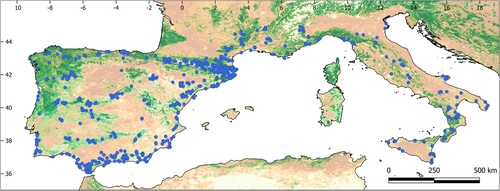
Data collection was carried out each year from March to October between 2014 and 2023, aligning with the seasonal activity periods of the target species (Escoriza et al., 2021, 2023). Most species were encountered opportunistically during random surveys, with habitat selection determined by accessibility rather than a pre-defined sampling strategy. However, an exception was made for microendemic lizard species, which were specifically targeted within their known distribution ranges. Fieldwork teams, consisting of two to four surveyors, characterised 3 to 6 localities per day during 8-h sampling periods. Squamates were detected through visual transects carried out during daylight hours and by lifting large objects such as stones and logs (McDiarmid et al., 2012). In total, 960 sites were assessed across an elevation range of 1 to 2553 metres (Figure 1).
2.2 Habitat-niche data
Squamate habitat preferences were evaluated by assessing two key variable sets: climate and terrain elevation (abiotic factors) and plant cover density (biotic factors) (Pike et al., 2011; Qian, 2010) (Table 1). Elevation was recorded in situ using a global positioning system with an accuracy of ±15 m (Garmin Etrex 10; Garmin Ltd., Olathe, KS, USA). To quantify climate effects, we used two variables: mean annual temperature (in °C) and mean annual accumulated precipitation (mm per year‒1). These variables were obtained from the WorldClim 2 database at 30 arc-seconds resolution (Fick & Hijmans, 2017).
| Class | Variable | Spatial resolution | units | Explanation |
|---|---|---|---|---|
| Climate | Average annual precipitation | 1 km2 | mm y‒1 | Available moisture |
| Mean annual temperature | 1 km2 | Celsius scale | Available energy | |
| Topography | Elevation | 5‒10 m | m above sea level | Terrain elevation |
| Vegetation structure | Species richness | 1 m | N species | Community diversity |
| Vegetation abundance | 1 m | N stems | Vegetation cover | |
| Simpson index | 1 m | ‒ | Species evenness | |
| Shannon-Wiener index | 1 m | ‒ | Species diversity | |
| Chao1 index | 1 m | ‒ | Species diversity |
The relative abundance of key plant species (trees, shrubs and perennial herbaceous plants) formed the basis for habitat characterisation. Habitat composition was determined through three 30-m transect surveys. To account for habitat variability, the abundance of plant species was measured along transects with a fixed width of 1 m, sampling from the central point of occurrence in three directions (north, southeast and southwest) (Escoriza et al., 2018). Plant species (trees, shrubs and perennial grasses) were classified following Castroviejo (2014), Thorogood (2018) and Ticli (2018). These data were used to calculate various measures of plant community diversity, including species richness, stem abundance and diversity/evenness indices (Simpson, Shannon-Wiener and Chao1; Kindt & Coe, 2005). These indices were selected because plant diversity is expected to decline with increased human disturbance (Honnay et al., 1999; Kindt & Coe, 2005; Kolb & Diekmann, 2004). Diversity indices were calculated using the BiodiversityR package (Kindt & Coe, 2005) in the R statistical programming environment (version 4.3.2; https://www.r-project.org/).
We employed a randomised sampling approach to measure canopy cover at five points along transects using a spherical crown densitometer (Forestry Suppliers, Inc.). The average height of dominant vegetation (10 stems, randomly selected) was measured as an indicator of forest maturity, as mature forests are typically taller due to the linear relationship between tree age and growth (Molina-Valero et al., 2021). We classified habitats into six distinct groups based on vegetation height and crown canopy cover (Carnahan, 1990): forests (tree crowns covering more than 50% of the area), further divided into medium (mean stand height between 10 and 30 m) and low (mean stand height between 2 and 9.9 m); woodlands (tree crowns covering between 20 and 49% of the area), also divided into medium and low categories; other woody vegetation (open woodland and shrubland with tree crowns covering between 5 and 19% of the area); and non-woody vegetation (shrubland under 2 m tall and grasslands). These classifications encompass various Mediterranean habitat types, including natural and artificially established forests, wooded pastures and shrublands (such as Iberian dehesas, garrigue and other woody vegetation), as well as alpine meadows, steppes and cultivated lands (non-woody vegetation).
2.3 Phylogenetic analysis
We explored the evolutionary relationships of the 56 squamate species recorded in this study using a Bayesian inference framework implemented in BEAST 2.6.7 (Bouckaert et al., 2014). Our data set comprised one nuclear and three mitochondrial genes, with a maximum sequence length of 2,586 nucleotides (Supporting Information file I). The data were divided into subsets, and the best-fitting model for each was identified using MEGA 11 (Tamura et al., 2021). The GTR model was applied to the ribosomal 12S and 16S genes and cytochrome b, while the T92 model was used for RAG1. A relaxed molecular clock model was implemented to account for variations in evolutionary rates and to estimate species divergence times, using seven calibration points. Three Markov Chain Monte Carlo (MCMC) simulations were run, each with 150 × 106 iterations. Convergence and effective sample size were monitored using TRACER 1.7.1. Samples were collected every 10,000 iterations, and the first 99% of each chain was discarded as burn-in. TreeAnotator 2.6.2 was used to generate the maximum credibility tree (MCT).
The MCT was used to calculate Faith's phylogenetic diversity (Faith, 1992). This index represents the combined branch length of the species in the phylogenetic tree, traversed by all lineages that compose a biotic assemblage (Faith, 1992). Higher values of this metric correlate positively with phylogenetic diversity (Faith et al., 2004). This index was calculated using the picante package (Kembel et al., 2010) in R.
2.4 Data analysis
The outlying mean index (OMI) was used to investigate the niche occupancy of squamate species (Dolédec et al., 2000). OMI analyses species occurrence patterns to compute the average niche of each species and contrasts it with the average niche of the overall species assemblage (species marginality). This analysis provides measures of inertia (the variability in species occurrence that can be directly attributed to the environmental gradients used in the analysis), niche breadth (tolerance) and unexplained variability in species occurrence (residual tolerance) (Dolédec et al., 2000). OMI analysis offers the advantage of being robust against multicollinearity among response variables (Dolédec et al., 2000).
In this study, we used the within-outlying mean index (WitOMI), an extension of the OMI analysis, to assess the environmental responses of species grouped by their specific niches (Karasiewicz et al., 2017). WitOMI also tests for significant subniche differences compared to average habitats using permutation tests (Karasiewicz et al., 2017). The p-values obtained were adjusted for multiple comparisons using Holm's correction (Holm, 1979). These analyses were carried out using the R packages ade-4 (Dray & Dufour, 2007) and subniche (Karasiewicz et al., 2017).
3 RESULTS
A total of 56 squamate species were recorded during sampling (2 species of amphisbaenians, 37 species of lizards and 17 species of snakes) (Figure 2 and Supporting Information file II). No forest-obligate species were identified, although one snake, Zamenis longissimus, was more commonly found in habitats with canopy density over 50% (present at more than 75% of sites). Two other species were predominantly found in habitats with over 20% canopy cover, also appearing at over 75% of sites: Chamaeleo chamaeleon (88%) and Vipera aspis (88%). Although most species did not show strong preferences for specific habitat types (Figure 3), some were predominantly associated with sparsely wooded environments featuring 5–19% canopy cover. This group mainly comprised cursorial (Acanthodactylus erythrurus, Psammodromus edwarsianus) and xeric specialists (Timon nevadensis) (see Figures 3 and 4).
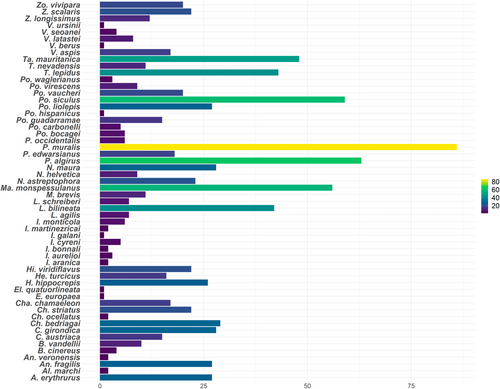
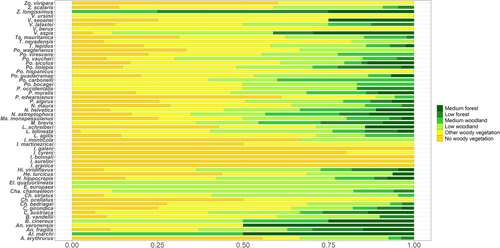
The first two axes of the OMI explained 89.69% of the total inertia (Table 2). The first axis (inertia = 68.15%) separated the sites based on their abiotic conditions, following a gradient determined by opposing temperature and precipitation vectors (Figure 4). This axis differentiated Mediterranean thermophilic species from subalpine temperate species (Figure 4). The second axis (inertia = 21.54%) separated the sites based on plant community diversity, distinguishing squamate species that occupy habitats with dense and complex vegetative communities (e.g., native forests) from those that inhabit compositionally simpler habitats, such as steppes and subalpine meadows (Figure 4).
| Variable | CSA1 | CSA2 |
|---|---|---|
| Explained variance | 68.145% | 21.542% |
| Average annual precipitation | 0.683 | 0.145 |
| Mean annual temperature | ‒0.638 | 0.114 |
| Terrain elevation | 0.638 | 0.114 |
| Species richness | ‒0.270 | 0.382 |
| Vegetation abundance | ‒0.232 | 0.153 |
| Simpson index | ‒0.249 | 0.227 |
| Shannon-Wiener index | ‒0.280 | 0.312 |
| Chao1 index | ‒0.203 | 0.348 |
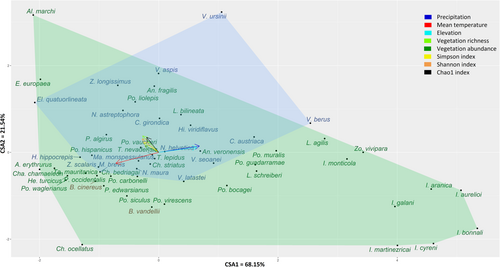
The WitOMI results indicated a reduction in niche sizes in habitats with denser canopies (Figure 5). Medium forest represented 30.25% of the total area, low forests 34.00%, medium woodland 44.81%, low woodland 68.83%, other woody vegetation 80.55%, and non-woody vegetation 83.14% (Figure 5). WitOMI analysis revealed significant differences between these forest categories in terms of habitat properties: forests and woodland supported richer plant communities than other woody or non-woody vegetation (Table 3).
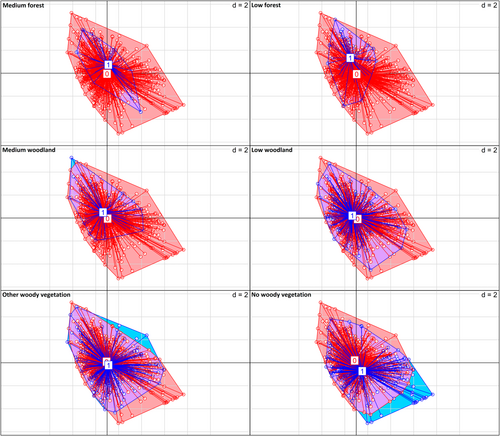
| N sites | Variables | Coefficient | p-value | Adjusted p-value | |
|---|---|---|---|---|---|
| Medium forest | 57 | Precipitation | 0.302 | 0.021 | 0.104 |
| Richness | 0.362 | 0.005 | 0.032 | ||
| Simpson | 0.319 | 0.014 | 0.084 | ||
| Shannon | 0.433 | 0.001 | 0.009 | ||
| Chao1 | 0.263 | 0.040 | 0.160 | ||
| Low forest | 55 | Richness | 0.828 | 0.0001 | 0.001 |
| Simpson | 0.548 | 0.0003 | 0.002 | ||
| Shannon | 0.725 | 0.0001 | 0.001 | ||
| Chao1 | 0.725 | 0.0001 | 0.001 | ||
| Medium woodland | 89 | Elevation | ‒0.218 | 0.032 | 0.149 |
| Richness | 0.301 | 0.003 | 0.020 | ||
| Simpson | 0.340 | 0.001 | 0.007 | ||
| Shannon | 0.376 | 0.0001 | 0.001 | ||
| Chao1 | 0.218 | 0.029 | 0.149 | ||
| Low woodland | 254 | Temperature | 0.186 | 0.001 | 0.003 |
| Elevation | ‒0.166 | 0.002 | 0.008 | ||
| Richness | 0.189 | 0.001 | 0.003 | ||
| Simpson | 0.195 | 0.0004 | 0.003 | ||
| Shannon | 0.235 | 0.0001 | 0.001 | ||
| Chao1 | 0.136 | 0.013 | 0.038 | ||
| Other woody | 297 | Richness | ‒0.150 | 0.002 | 0.016 |
| Shannon | ‒0.134 | 0.005 | 0.036 | ||
| Chao1 | ‒0.101 | 0.036 | 0.215 | ||
| No woody | 208 | Temperature | ‒0.143 | 0.020 | 0.049 |
| Elevation | 0.195 | 0.002 | 0.005 | ||
| Richness | ‒0.463 | 0.0001 | 0.001 | ||
| Simpson | ‒0.509 | 0.0001 | 0.001 | ||
| Shannon | ‒0.566 | 0.0001 | 0.001 | ||
| Chao1 | ‒0.378 | 0.0001 | 0.001 |
- Note: p-values were adjusted for multiple testing using Holm's correction. Statistically significant values are shown in bold.
The WitOMI results also showed that habitats with denser canopies support lower squamate species richness and lower phylogenetic diversity (Table 4). For example, medium forests included 24 species, whereas low woodland supported 40 species (Table 4). Furthermore, species occupying forests showed greater marginality (WitOMI = 80.6‒85.3) and lower tolerance (6.9‒7.4) compared to species occupying non-forest habitats (other woody/non-woody vegetation; WitOMI = 50.0‒65.8; tolerance = 9.4‒11.4) (Table 4). Residual tolerance was consistently low (7.8‒38.6) (Table 4), indicating that predictor variables accounted for a substantial part of the environmental variance between species. The OMI parameters and their statistical significance for each vegetation category are provided in Supporting Information file III.
| N species | Faith's index | WitOMI | Tolerance | Residual tolerance | |
|---|---|---|---|---|---|
| Medium forest | 24 | 1326.8 | 80.6 ± 5.2 | 7.4 ± 2.6 | 11.9 ± 3.3 |
| Low forest | 26 | 1628.2 | 85.3 ± 3.8 | 6.9 ± 2.6 | 7.8 ± 1.9 |
| Medium woodland | 33 | 1769.3 | 71.2 ± 5.5 | 6.4 ± 1.6 | 22.4 ± 4.3 |
| Low woodland | 40 | 2064.7 | 53.1 ± 5.0 | 12.9 ± 2.1 | 33.9 ± 3.7 |
| Other woody vegetation | 46 | 2113.7 | 50.0 ± 4.9 | 11.4 ± 1.8 | 38.6 ± 4.3 |
| No woody vegetation | 42 | 1910.9 | 65.8 ± 4.7 | 9.4 ± 1.9 | 24.9 ± 3.5 |
- Note: N species is the number of squamate species that occur in each forest category. Faith's index represented the combined lengths of the species respective branches on the phylogenetic tree, traversed by all lineages within an assemblage. WitOMI assesses the distance between the preferred conditions of the species and the average available environment. Tolerance is the niche breadth. Residual tolerance is the percentage of unaccounted variability.
4 DISCUSSION
For thousands of years, human activities have shaped the ecosystems of the Mediterranean region. Traditional agriculture maintained a patchwork of habitats that supported highly diverse biotic communities (Baiamonte et al., 2015). However, industrialisation intensified forest exploitation, introduced nonnative tree species and homogenised open areas through urbanisation and intensive agriculture, leading to biodiversity loss (Brotons et al., 2018; Henle et al., 2008). Additionally, the disuse of open areas due to reduced grazing has allowed forests to reclaim land, negatively impacting species reliant on open habitats (Preiss et al., 1997; Stefanescu et al., 2011; Suárez-Seoane et al., 2002), potentially including reptiles. These trends highlight the long-term, complex effects of human activity on Mediterranean biodiversity.
In this study, we tested the hypothesis that squamate reptiles would show negative responses to denser crown canopies and greater vegetation stand height. Our results confirmed that canopy cover exerts a strong influence on squamate presence. We found that open woodland formations and open habitats with scattered trees (canopy cover between 5 and 49%) support higher species richness and phylogenetic diversity. These ecotones provide suitable environments for both generalists and specialists alike, as cursorial forms benefit from open patches, while mesic species find protection from temperature extremes within vegetation cover (Gregory & Tuttle, 2016; House & Spellerberg, 1983; Salvador, 2014). Furthermore, similar findings from transitional woodland in southern Greece (Ioannidis et al., 2008) suggest that these results may apply across the entire Mediterranean ecoregion.
We also observed that forest habitat quality measures (such as stand height, crown density and plant community diversity) are inversely related to squamate diversity. In contrast, other temperate faunal groups such as salamanders, bats, birds and insects often prefer mature primary forests, which support greater biodiversity and provide crucial habitats for rare species (Basile et al., 2021; Curtis & Taylor, 2004; Ford et al., 2002; Piksa et al., 2022; van Halder et al., 2015).
These findings align with the observation that forest canopy cover can have a significant negative impact on habitat quality for heliothermic reptiles (Thompson et al., 2018; Webb et al., 2005). Reduced sunlight exposure forces adults to exert more effort to regulate body temperature, increasing their exposure to predators and decreasing embryo survival rates (Downes, 2001; Schlaepfer, 2003). Climbing species, such as Chamaeleo chamaeleon, can thermoregulate by using the elevated and potentially sun-exposed branches of trees and shrubs (Hódar et al., 2000), while species with lower thermal requirements, like Zamenis longissimus, may have an advantage in shaded environments (Rugiero et al., 2002). However, a substantial number of Mediterranean squamates either avoid densely shaded habitats or use them by favouring discontinuities such as rock outcrops, paths or forest edges (Amo et al., 2007).
Human management of habitats can enhance squamate diversity, as demonstrated by traditional agro-pastoral oak woodland pastures, which support more species than homogeneous native forests due to a dense understory of low shrubs (Martı́n and Lopez, 2002). Conversely, areas subjected to intensive agricultural practices and aggressive reforestation efforts show a marked decrease in reptile species, likely due to the combined effects of reduced availability of refuges and food resources, as well as the widespread use of toxic chemical agents (Kazes et al., 2020; Luiselli et al., 2018; Rugiero et al., 2021).
5 CONCLUSIONS
In Europe, forests play a critical role in nature conservation by sequestering atmospheric carbon dioxide and supporting specialised biotic communities in mature forests (Nabuurs et al., 2015; Plath et al., 2024; Vergara-Tabares et al., 2018). However, maintaining a balance between forests and open natural habitats would significantly benefit biodiversity. Our results indicated that species richness peaks in open woody formations with crown canopy densities below 50%. These findings have important implications for the conservation of Mediterranean squamates. Intensive reforestation campaigns should be avoided in areas particularly rich in reptile species, such as nature reserves, Mediterranean coastal mountain ranges (Balletto et al., 2010; Lescure & de Massary, 2012) or areas with high conservation value for threatened species.
When considering strategic reforestation programmes that address soil conservation and long-term timber use within a sustainable framework, trees should be spaced appropriately to allow sunlight to filter through to the ground, or plantations should be intersected with wide gaps (Bragg et al., 2005). A promising approach could involve novel, landscape-scale reforestation strategies that integrate both woodland and open habitats (Douglas et al., 2020).
AUTHOR CONTRIBUTIONS
Daniel Escoriza: Conceptualization; formal analysis; investigation; resources; supervision; writing the original draft. Félix Amat: investigation; writing the original draft.
ACKNOWLEDGMENTS
We acknowledge the support provided during the fieldwork by Guillem Pascual, Laia Mestre, Jihene Benhassine, and Roberto López. Authorizations for fieldwork were provided by the Departament de Medi Ambient (ref. SF/574).
CONFLICT OF INTEREST STATEMENT
The authors declare no conflicts of interest.
Open Research
DATA AVAILABILITY STATEMENT
Data available within the article or its supplementary materials.



